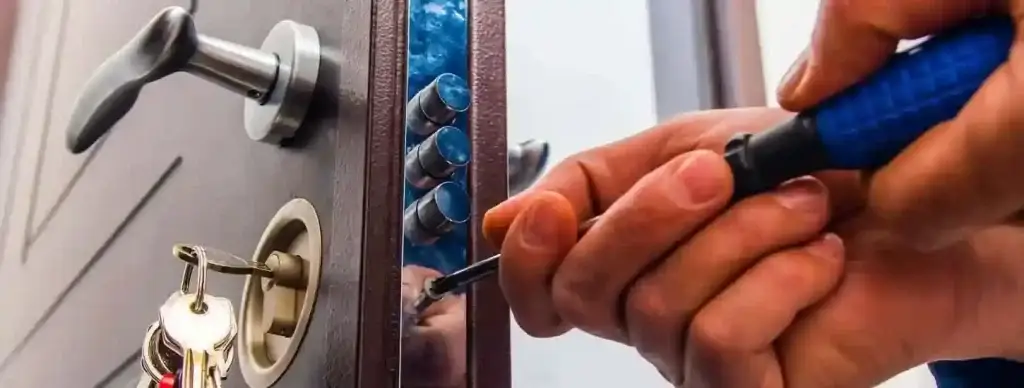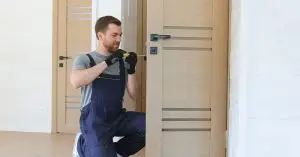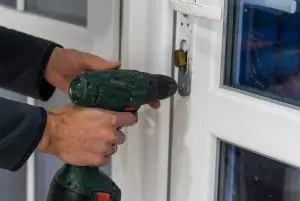Your Smart Lock Isn’t Responding Consistently
When we rely on smart locks for everyday security, response time is critical. That is to say, when you tap the app or enter your code, the lock should engage or disengage without delay. If it starts to hesitate, freeze, or work only after multiple tries, it’s a red flag.
This kind of behavior often points to software bugs, dying batteries, or mechanical wear. Consequently, if troubleshooting doesn’t solve the problem, it could be a sign that your smart lock is nearing the end of its useful life. We’ve seen many people try to patch the issue temporarily, but it usually returns worse than before.
In situations like this, it’s important to ask whether reliability is worth gambling on. To avoid future lockouts or security gaps, we recommend exploring updated hardware through a professional lock installation service in Calgary.
The Battery Dies Much Faster Than It Used To
Smart locks use batteries for everything from Bluetooth to motor function. However, when a device that used to last six months is suddenly draining batteries in just one, it’s a warning sign. In other words, batteries should degrade slowly—not dramatically.
This kind of power drain often stems from internal motor strain, damaged circuits, or signal processing problems. Above all, your lock should not be a maintenance headache. If you find yourself changing batteries more than once every couple of months, there’s likely a deeper issue.
We usually advise customers to avoid patchwork fixes at this stage. Replacing the lock is often more cost-effective in the long run, especially when considering time and battery expenses. And if you’re unsure, a reliable Locksmith in Calgary can help evaluate the situation clearly.
Your Lock Doesn’t Fit Snugly Anymore
Over time, homes shift slightly, doors sag, and hardware loosens. So if your smart lock doesn’t sit flush or feels loose when you turn it, this may compromise your security. That is to say, any misalignment could allow tampering or prevent the lock from functioning at all.
We’ve also seen this happen with warped doors or degraded strike plates. A tight, secure fit is essential to ensure both mechanical and digital locking systems function correctly. In some cases, reinstalling the lock properly fixes the problem. However, if the body has warped or worn down, a full replacement may be necessary.
If you’ve noticed this happening, it may be the right time to talk to a professional about modern smart lock options that better fit your door’s current shape and structure.
Your App Keeps Disconnecting or Crashing
App issues are a common complaint with aging smart locks. Sometimes it’s just a matter of updating firmware, but in other cases, the device’s internal software becomes outdated. Consequently, users start experiencing frequent disconnects, missing lock logs, or complete crashes.
This isn’t just annoying—it’s a safety risk. In other words, if you can’t verify whether your door is locked or not, you’re left guessing. The whole purpose of smart tech is to enhance convenience and control, not create uncertainty.
While some app glitches are temporary, recurring issues signal it’s time to move on. If the lock is no longer supported or the app doesn’t work on your new phone, your best option may be a replacement with current software compatibility.
The Lock Mechanism Feels Sticky or Sluggish
Even the most high-tech smart lock still includes moving parts. Therefore, when you start noticing a sticky turn, grinding noise, or delay between command and action, mechanical wear is likely at play. That is to say, electronics can’t compensate for deteriorating gears or motor fatigue.
In many situations, a bit of lubrication or a fresh alignment helps. However, if the sluggishness returns quickly, it’s usually a sign the internal components are failing. We’ve seen this especially in locks installed in high-traffic doors or exposed to extreme Calgary weather.
It’s better to act before the mechanism fails completely. In fact, it’s a common cause of emergency calls when the lock jams while someone is trying to enter or exit.
You’ve Had a Break-In Attempt
If someone has tried to force your smart lock or damage the keypad, don’t assume everything is still secure. While the device may look fine, hidden damage can affect function. Moreover, it can compromise encryption or mechanical integrity in ways you can’t easily see.
After a break-in attempt, we always recommend a full evaluation. If there’s any doubt, it’s usually safer to go with a fresh installation. Peace of mind matters, especially after a stressful event. And if you’re unsure where to begin, it may help to reach out through a locksmith contact service in Calgary for a proper checkup.
Your Lock Doesn’t Support Your Current Tech
This last red flag often creeps up slowly. Maybe you’ve upgraded your phone, changed Wi-Fi routers, or installed a new smart home system. Over time, your smart lock might start falling out of sync with the rest of your setup. It may no longer support app integration, or it might lack security updates.
Smart technology evolves fast. Consequently, older locks may not be compatible with current encryption standards or may stop receiving firmware updates. If your device feels outdated compared to everything else in your home, it might be time to move forward.
We’ve found that integrating locks with newer home systems not only improves ease of use but also reinforces overall security. Compatibility matters, and when your smart lock lags behind, your entire system suffers.
Extra Tip: Don’t Wait for Total Failure
Most people wait until their lock completely fails before thinking about a replacement. However, that usually means getting locked out, scrambling for a fix, or exposing the home to risk. To clarify, waiting too long turns a simple issue into a stressful problem.
Instead, we suggest treating locks like other essential tools—replace them before they break. That’s especially true with smart locks that control primary entry points. You wouldn’t wait until your brakes fail to replace them. Similarly, your lock should be treated as critical security gear, not a background gadget.
Replacing a smart lock before it fully fails is a smoother, safer process. You get time to research, plan, and install without the urgency of a crisis.
FAQ
How long does a smart lock usually last?
Most smart locks last three to five years, depending on use, environment, and battery management. Daily use or poor weather exposure may shorten that lifespan.
Can I replace my smart lock without changing the door?
Yes, many smart locks are designed to retrofit standard doors. As long as the door and frame are in good condition, replacement is typically simple.
What’s the most common failure in aging smart locks?
The most common issue is inconsistent locking or unlocking. This usually stems from failing motors or misaligned components after long use.
Is it better to repair or replace a failing smart lock?
If the problem is app-related or minor, a repair might work. But if mechanical or power issues persist, replacing the unit is more reliable and cost-effective.
How do I know if my smart lock is still secure?
Check for regular firmware updates, monitor connection reliability, and ensure encryption matches modern standards. If support has ended, consider upgrading.





